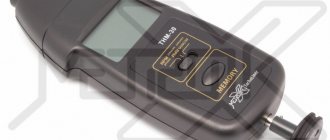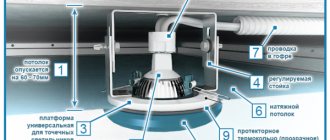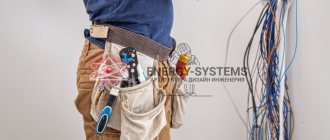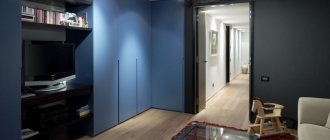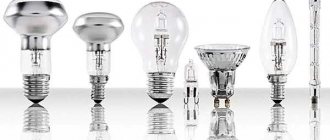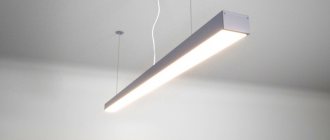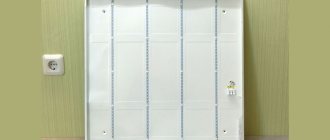Lighting elements
Now let’s look at the components of each lamp, because inside the same model you can put lamps of different types, and surround the outside with a lampshade, which will make the sauna more comfortable and stylistically uniform.
Lamps
The following types are allowed in the sauna steam room:
- incandescent lamps;
- LED;
- halogens.
ATTENTION! Please note that we are only talking about lamps, so we will not mention LED strips and fiber optics, although they can also be installed in the steam room.
Incandescent lamps
Ordinary lamps, known since time immemorial when the entire country was electrified.
The only limitation that should be taken into account concerns power - it is not recommended to use more than 60 W in the steam room, but there are no restrictions on the number of light bulbs. However, there are two unpleasant aspects associated with them:
- Firstly, they are quite fragile, break easily, and burst easily if cold (relative to their own temperature) water gets on the flask when it is heated.
- Secondly, they are connected to a 220 V network, so if there is a problem, a person can be killed by such a current. Moreover, in a bathhouse, where it is humid and water conducts electricity very well. True, there is an option: installing 36-volt ones through a transformer, many people practice it.
To protect against the first - lampshades, nets and lampshades. From the second - RCD.
LED bulbs
LEDs can be in the form of lamps and in the form of strips. Here we will consider only lamps. More complete material can be found at this link.
The sockets are different, but the E27 socket is typical for bath lighting - this is a medium threaded socket with a diameter of 27 mm, which is suitable for incandescent lamps, and for LED lamps (if they are designed for 220 V), and for halogen lamps.
BY THE WAY! LEDs are still installed in the bathhouse not so much for the sake of reducing energy consumption, but because they are powered from a low-voltage network, most often 12 V (24 and 36 V are also possible).
For LED light bulbs that are powered from a 220 V network, you can also install an RCD. And for 12-volt ones, connect either a step-down transformer (see article on electricians in a bathhouse) or a switching power supply.
IMPORTANT! The power supply should preferably have galvanic isolation, which will not allow 220 V to flow into the circuit in the event of a failure. The transformer and power supply are installed outside the steam room
The transformer and power supply are installed outside the steam room.
And now the most important thing: you can put LED lamps in a sauna, but they will not last long, because for them the temperature is already above 65 degrees on the crystal. Just imagine that the crystal itself gets very hot during operation, so heat removal is needed, which is unattainable in an overheated sauna.
So you either need to place the strips somewhere lower, as a backlight, or abandon the idea of LEDs altogether, and use regular incandescent or halogen light bulbs closer to the ceiling.
Halogen
These bulbs tolerate high temperatures well, but are not without their drawbacks. In particular, this concerns their service life. Interestingly, LEDs do not respond to the number of times they are turned on, while for halogen ones, each turn on reduces their service life.
In principle, you can find both 220 V and 12 V halogen ones on sale, but the latter have a different base from the standard E27, and in general they are not intended for insertion into conventional structures with lampshades.
Varieties
There is a wide range of lighting products on the market, but not every model is suitable for a bathhouse, since the difference in temperature and high humidity in the room are not suitable for every lighting device.
There are several main types of bath lamps, including waterproof, heat-resistant, LED, moisture-resistant, low-voltage, wireless, and so on. We need to talk about everything in order:
Halogen lamps
The most heat-resistant lamps are halogen. The power of such lamps ranges from 20 to 35 Watts, the maximum heating for them will be 400 degrees. An important aspect is that the voltage used by the lamps is not dangerous to people, and their contacts are protected from moisture. In addition, halogen lamps have a pleasant appearance; it is possible to select shades of different colors.
LED lights
LED lamps are one of the most economical and environmentally friendly lighting options, however, it is better to place them as low as possible in the steam room, since they are quite difficult to tolerate heat and moisture. Such lamps are often used as lighting; they can be placed behind shelves; they can illuminate the room in different colors, since their spectrum is quite wide.
A room with LEDs will always be well lit, and such lamps do not consume a large amount of electricity.
When purchasing waterproof lamps for a bath, you need to consider several aspects:
- On the box or frame of the lamp you need to look at information about how high the degree of protection of this model is from humidity; for this there is a certain international classification; An IP value of 45 and higher will be acceptable.
- In addition to the fact that the lamps must be moisture-resistant, they must also be heat-resistant - in a steam room, the air temperature can fluctuate from 60 to 120 degrees and the lamp must be designed for such temperature fluctuations; Well, for ceiling models the standards are even higher, since they need to work at temperatures up to 300 degrees Celsius.
Fiber optic lamps
The best waterproof lamps are fiber optic lamps. By purchasing a fiber-optic lighting device, you can be sure of its moisture resistance, even without paying attention to the degree of protection factor. This is possible due to the specific properties of the material; it is capable of transmitting only light waves, but not electricity. These lamps can also be used in water tanks and swimming pools.
Also, the advantage of these lamps will be a fairly soft light, which will help create a cozy atmosphere and relax.
Options for bath lamps
Among the bath lamps that are especially popular, the following lighting options are distinguished.
Waterproof lamps for baths
To choose the right lamps for a steam room in a bathhouse, you need to consider the following important indicators:
- The level of resistance of lighting devices to high humidity and coarse particles. In accordance with the international classification, the value must be higher than IP. You can view this information either on the lamp body or on the packaging. Often the humidity in the bath is 100%.
- Resistant to high temperatures. The chosen lighting option must be heat-resistant, since the air temperature varies in the range of 60-120 degrees. Considering this nuance, it is worth purchasing a lamp with the highest possible protection. For example, the air in a Russian bathhouse warms up to 100 degrees, in a Turkish bath – 150. If you need to install lamps on the ceiling, then you should pay attention to models with the ability to withstand temperatures of 200-300 degrees.
Important!
Before purchasing lighting fixtures for the bathhouse, you need to make sure there is a reliable seal. Only a silicone and rubber gasket located between the body and the protective glass can prevent moisture from entering the lamp. The optimal solution is to install models equipped with LED or energy-saving lamps, the degree of incandescence of which is significantly less than that of conventional ones. It is noteworthy that most of the presented lamps for the steam room in the bathhouse are equipped with milky frosted glass, which allows you to achieve soft, even and diffused light. This glass copes well with sudden temperature fluctuations and water splashes. These varieties are universal, suitable for placement on the ceiling surface and under it.
Heat-resistant lamps
To organize effective and safe lighting in a bathhouse, where the air temperature is above 100 degrees, you need to choose devices that are as resistant to such conditions as possible. These are lamps made of glass, heat-resistant plastic and metal.
If you use inexpensive Chinese-made lamps to equip a steam room in a bathhouse, then almost after the first use they will become unusable - they will melt right on the wall or ceiling. Therefore, it is best to purchase high-quality heat-resistant lighting fixtures that are characterized by their ability to withstand temperatures of 120 degrees or more. In addition, special attention should be paid to the material from which the cartridge is to be made. It should be ceramic; carbolite products are not suitable for a steam room in a bathhouse.
Halogen lamps
This type of bath lighting is characterized by the presence of halogens in the gas mixture, which is located under a glass bulb. Thanks to this structure, the lamp has a number of positive characteristics:
- High level of heat resistance. Considering that the lamp can heat up to +400 degrees from the inside, it can be actively used to organize lighting in the steam room.
- Availability of protection against dust particles and water splashes. You can familiarize yourself with this parameter in the information for a specific sample.
- Relatively low power rating. It varies in the range of 20-30 W.
- Presentable appearance. A huge range of options allows you to choose the most suitable shade color that matches your interior.
- Pleasant light spectrum that matches natural light as closely as possible.
The only disadvantage of halogen lamps is their high cost. This applies to samples with a high degree of resistance to excessive humidity.
LED lights
On the market, such lighting devices are presented in the form of strips; they are excellent for decorating niches, benches, and baseboards. They can be effectively placed in semi-hidden places, just like fiber optic cables. There are also beautiful spotlights. The advantages of LEDs include:
- economical energy consumption;
- wide range of color effects;
- increased level of resistance to moisture;
- long service life;
- safety in use;
- do not cause any difficulties during installation.
There are practically no disadvantages to LED devices; it is only recommended to use them in the dressing room or washing room. Due to the low level of resistance to high temperatures in the steam room, they should not be installed. Advice! As an option, if desired, you can place LED lights in the lower part of the steam room.
Fiber optic lamps
This is one of the modern bathhouse lighting options, which are presented by the manufacturer in the form of an elastic cord consisting of acrylic or glass fibers. In them, light spreads quite freely and is generated by the projector.
Advantages of fiber optic lighting products:
- the ability to transmit exclusively light waves, and not electricity;
- Possibility of use in water containers, swimming pools;
- presence of soft light;
- creating a relaxing and pleasant atmosphere in the room;
- high degree of resistance to high temperatures and humidity;
- universal purpose;
- long service life;
- economical energy consumption.
Advice! To create the effect of a starry sky or an original interior solution, it is better to lay optical fiber in special niches.
Lamps: which ones can be installed, which is better
In addition to choosing the shape of the lampshade, you also need to decide what kind of lamps you will put in it.
In the bathhouse, 60-watt incandescent lamps, LED lamps and strips, as well as halogen and fiber-optic light sources are acceptable.
Bath light bulbs: incandescent lamps
In the old days, there simply weren’t any other options. However, this variety is very fragile and sensitive not only to mechanical stress, but also to sudden temperature changes, for example, when water gets on the flask. Therefore, they are dangerous by the very presence of glass and a red-hot spiral.
Another factor not in their favor is the voltage they consume - 220 volts can kill a person if the unexpected happens. Although there are 36 volt light bulbs, they can work through a transformer.
You can protect yourself from electric shock by installing an RCD (more details in this and this article on our website). In this case, the current will turn off so quickly that it will not have time to harm a person. And the lampshade with a mesh should protect the flask from mechanical destruction.
CONCLUSION: you can use such light bulbs for a bath not only in dry rooms, but also in wet ones, including a steam room. But taking into account protective measures. In addition, this is the most budget-friendly type.
Fiber optic
Optical fiber is not cheap, but if this is not a question, then it can be used to illuminate a relaxation room, a steam room, and a swimming pool.
On sale you will find two types of cables - with side and end glow. The difference is clear: in the former, the light spreads from the entire surface of the cable, while in the latter, the cable itself does not glow, but a bright light shines from the cut at its end. A cable with a side glow may have internal notches that make the glow inhomogeneous and chaotic.
Both varieties are suitable for installation in bathhouses.
The lamp structure includes a projector and cables of the required length.
ATTENTION! If you intend to use fiber optics in the steam room, then the projector must be located outside it, although not too far, literally behind the wall.
The projector can be equipped with crystals and discs of different colors.
LEDs
In principle, if you are interested in this topic, you can look at a large material dedicated only to LEDs for baths.
Here we will describe them briefly. LEDs can be a strip or a lamp. The latter is screwed into a regular socket; the mains voltage can be 220 or 12 V.
To power 12-volt LEDs, either a step-down transformer or a power supply is used. If a power supply is used, it must have galvanic isolation, which ensures that even in the event of a failure, 220 V will not flow to the consumer.
LEDs are sensitive to two factors - current fluctuations in the network and high temperature (above 65 degrees on the chip). This shortens their service life.
Installing them in a steam room is undesirable, but beneficial - low voltage, low energy consumption. Therefore, the high temperature trade-off is usually resolved by mounting the LEDs low in height (where the temperature is lower). If these are tapes, then they are laid under and behind the shelf.
IMPORTANT! Tapes used in wet rooms must have a high degree of moisture protection - placed in a transparent sealed tube, at a minimum. As a maximum, transparent silicone is filled inside the tube.
Underground input
This method is the most reliable, but there are cases when it is not entirely appropriate.
It all depends on where the bathhouse will be located and whether it will be possible to dig a trench to it. Let's first look at all the advantages of underground input:
- A cable laid in the ground will not be exposed to strong winds, precipitation, or sudden temperature changes throughout its entire service life.
- If a short circuit occurs and an electric arc occurs, underground cable entry ensures that property and people will not be harmed.
- An important factor is that the architectural style and appearance of the site are not disturbed. All communications are hidden in the ground, no cables or wires spoil the overall picture.
- If you do not live in a country house permanently, then there is a possibility of theft. Unfortunately, this fact is still possible; there are skilled people who steal wires and cables laid over the air. It’s unlikely that anyone will decide to dig an underground connection. This is another important advantage.
However, this method also has its drawbacks. You will have to dig a trench. If you do it yourself, you will spend a lot of time and effort; if you start hiring people, considerable financial costs will follow. In addition, in order to carry out excavation work, you will need coordination with various organizations that may have communications running through the territory of your site (electrical cables, water or gas pipes, communication lines).
And one more important nuance. The earth is also an environment that is not entirely prosperous, one might even say aggressive. Due to the chemical composition of the soil, corrosion processes may occur, as a result of which the cable sheath will become unusable. Tree roots, microorganisms and rodents living in the ground can have a negative impact, and groundwater can also have a negative impact.
The best option for underground input would be a VBBShV cable with a cross-section of 10-16 mm2. It is not cheap, the price is about 200 rubles per meter, but it is durable and reliable. The four copper cores, in addition to being in an insulating sheath, also have a steel braid.
Dig a trench to a depth of at least 0.7 m, add a 10 cm layer of sand to the bottom. When you lay the pipe with the cable, also cover it with a sand layer on top, and only then fill it with soil.
This option is considered cheaper in terms of material and physical costs. The mere fact that you don’t need to dig a deep trench already saves effort, money and time.
You will need to string a wire or cable from the house building to the bathhouse. I would like to warn you right away that if the house is located in one part of the site, and the bathhouse is completely opposite, then, most likely, this option will not be rational due to the large distance between them. The wire will be subjected to very high mechanical loads and may break under its own weight. You won’t install a few more additional supports, it’s expensive and not very beautiful for the area.
We invite you to familiarize yourself with the house plan with garage and bathhouse
If the distance between the house and the bathhouse is less than 20 m, then the air input is quite acceptable. In this case, the work algorithm will look like this:
- Drill holes in the walls of the house and bathhouse according to the diameter of the cable. They will need to install a piece of metal pipe or special plastic corrugation.
- Next to the drilled holes, install brackets on which to secure the insulators.
- Stretch a steel cable between these two insulators.
- Secure the cable to the cable using plastic or metal clamps. Place it into the prepared holes. And now all that remains is to connect it. In the distribution panel located in the house, you need to install a separate machine for the bath, and this cable should be connected to its output contacts. In the bath switchboard, the cable is connected to the input general circuit breaker.
As you can see, the electrical installation of the air inlet is not complicated, but you will need to take into account some nuances:
- The places where the cable leaves the house and enters the bathhouse should be sealed. After tightening it into the pipes, seal the remaining space with polyurethane foam or compact it with non-flammable mineral wool.
- Ensure sufficient tension in the steel cable.
- There should be no other outbuildings, tall bushes or trees in the cable path.
- The distance from the ground to the conductor must be more than 3.5 m.
- Do not pull the cable too tightly, it is not a string, attach it to the steel cable loosely.
The best option is to use a wire marked SIP (self-supporting insulated wire) for the air input. It has a certain design feature: in addition to the conductive aluminum conductors, there is a steel cable under the shell.
Another advantage of SIP is that its insulating shell is made of materials that can withstand precipitation and sunlight well.
It is possible that the air inlet to the bathhouse will be mounted from the main power line. This may be the case when the bathhouse is located near such a line and it is more expedient to draw the input from it than from the house. This will require a special permit and design from the energy supply organization, as well as the installation of an electricity meter in the sauna switchboard.
How to make your own fiber optic lighting in a bathhouse
Which lamps are best for a bathhouse is up to the owner to decide, but experts recommend fiber optic lighting. These light sources are used to equip steam rooms: they can withstand temperatures up to 200 °C, do not dazzle the eyes, and are therefore optimally suited for use without wooden lampshades. Fiber optic lighting for a bathhouse is the safest and most durable, easy to install, applicable in exclusive interior design (for example, using lenses and special crystals you can make original lamps with the effect of flowing water, northern lights or burning flames).
For safety reasons, it is better to install LED lamps in a steam room from below, for example, under benches, since the temperature near the floor is much lower than near the ceiling. Here the devices will function more stably.
Making a lamp for a bathhouse with your own hands is not difficult, and it will not cost much. For this you will need: wood (possibly what was left over from construction work), plywood, glass 4 mm thick, a special PET film resistant to temperatures of at least 120 ° C, electrical insulating material getinax, LEDs with a lighting angle of 120 °. Also, for do-it-yourself lighting in the bathhouse, you need to purchase aluminum tape, superglue and assembly adhesive.
Before making lighting in the bathhouse, templates of the main parts are made from fiberboard. According to the template for the lamp frame made of linden wood, vertical slats with rounded edges are planed: 4 pieces measuring 750x35x15 cm, 8 pieces measuring 750x40x15 cm, 4 pieces measuring 750x45x15 cm and 1 piece - 550 - 50 -20 cm (it will be needed when arranging a groove for glass).
1. The main parts for lighting the steam room in the bathhouse are fastened with slats and coated with universal mounting adhesive; the fastening points are tightened using self-tapping screws 70 mm long.
2. Before making fiber optic lights for the bathhouse, specially designed strips are attached to support the glass. The glass is cut out and wrapped in PET film as insulation.
3. Then the slats are sawed, tried on, coated with mounting adhesive and tightened with self-tapping screws.
4. On two slats measuring 750 x 45 x 15 cm, mark the points where holes for the glass are subsequently drilled. With the help of slats it will be fixed in its place. In this case, the outer vertical slats are fixed with screws from the reverse side.
5. Print out a table with 3x3 cm cells on a computer, glue it to a sheet of getinax and drill in the places where the lines intersect. The diameter of the resulting holes should be 5 mm - just the diameter of the LED. A larger drill is used to make conical recesses so that the light from the LEDs is more directional. The paper is washed off the part with water.
6. LEDs (80 pcs.), soldered in groups of 4, are attached to the back side of the panel with superglue. There will be 20 LEDs in total - 4 at each point. The lamp is designed for 12 V. The reflector for the LEDs will be aluminum tape.
7. Install the power supply as for halogen light bulbs. Place it outside the steam room, connecting the cable to the lamp through the wall. This original lamp will consume only 250 mA, or 3 W.
8. Attach all the slats (they should not be visible from the front side) to the frame using self-tapping screws. The panel with LEDs is wrapped in PET film and attached to the base.
Now you know how to properly make lighting in a bathhouse; below you can familiarize yourself with the rules for installing lamps.
How to install lighting in a bathhouse: installation of distribution boxes
The configuration and dimensions of distribution boxes depend on the conditions in which they will operate, as well as on the number of wire connections. The hidden junction box can be equipped with a protective gasket (suitable for a bathhouse) or without it. A rubber ring on the lid seals its connection to the box. If there is no gasket, the cover is attached with screws or snapped into the grooves.
If the cable is enclosed in a plastic pipe, then it must extend 1-3 cm into the junction box so that the cable does not remain unprotected. This also applies to installation boxes. If the box is compact, then a diamond bit can be used to drill a hole in a concrete wall. But this method is suitable only when the diameter of the distribution box does not exceed 70-100 mm.
If the box is large, use a diamond crown to make several adjacent recesses and trim the hole with a chisel. The depth of the recess should be such that the junction box cover, when closed, is flush with the wall surface.
At the next stage of installing the junction box, you should lay all the necessary wires in it.
1. Lead all connected wires inside the junction box. There are plastic hatches on the bottom and sides of it: you need to break them off and insert the ends of the cables into the resulting holes.
2. The wires are connected to each other using terminals, caps, terminal boxes, clamps, or hand twisting. Additionally, the wires are wrapped with electrical tape, twisted, hidden in a box, covered with a lid and placed in a recess specially made for it. Next, they are fixed in it using plaster or plaster.
It is quite possible to handle the installation of electrics in a bathhouse with your own hands. The main thing is to choose suitable electrical appliances designed for wet and hot rooms, and carefully install them.
Light: types of lamps
Let's start with the fact that a bathhouse usually has not one room, but several, and a comfortable stay in them requires sufficient lighting. It’s not bad if you can choose something that suits your style. Let's look at a few popular varieties.
And if you are interested in the specifics of light sources in a Russian steam bath and a Finnish sauna, we recommend that you follow the links.
Ceiling lamps
Lampshade - this name was originally coined for a round ceiling lampshade. However, over time, it began to refer to all translucent solid lampshades made of glass or plastic.
BY THE WAY! If you want to learn more about what kind of lampshades can be used in a bathhouse, read this material.
Matte bath lamps are usually used in steam rooms and washing rooms. At the same time, quite often they have another, additional lampshade made of wood, which serves as additional protection against mechanical damage and water getting on the heated surface of the lampshade.
Those located in wet areas are subject to the requirement of moisture protection. In the dressing room or rest room you can place any model suitable for residential premises and suitable in design.
Chandeliers
Well, in our opinion, this is said too loudly: “chandelier for a bathhouse.” Still, we must take into account the meaning of the word. A chandelier is when something hangs from the ceiling in the form of a cluster of lamps with shades. At least with one lamp. It is difficult to combine in your mind the image of a wooden interior (and most people choose it) and a more or less classic chandelier. However, it is possible that people are simply using this word instead of saying "lamp".
Okay, be that as it may, we were wondering if it was possible to choose suitable models for the rest room, for example (other rooms are not the topic at all). And you know, in principle, they exist.
For example, it could be a wooden wheel, like from an ancient cart, which is suspended from the ceiling on chains, and such pointed light bulbs in the form of lights are attached to the rim. These, it seems, were in taverns, and are quite in harmony with the wooden walls.
Hanging chandelier Daddy`s Pipes Photo source: funale.ru
If you don’t want to imitate antiquity, you can buy or make this option yourself: a meter-long wooden beam with light sources mounted in a row, suspended either on chains or on cables. Also interesting are more complex structures made from similar beams - for example, connecting them into a triangle or other shape.
Lanterns
A good option that will fit into the interior of the dressing room, and, if the size is suitable, then into a small rest room.
Depending on the interior, the type of lantern for a bathhouse can be extremely utilitarian (a mesh for a lamp with a visor on top) or even pretentious, with rich forging and metal decorations.
Another point of choice is that on sale you can find lanterns in the form of sconces that are attached to the wall, in the form of a chandelier that is attached to the ceiling, and in the form of a free-standing lamp (there are table and floor versions).
Distribution panel and load calculation
All electrical wiring is routed in the bathhouse from the distribution board. When choosing a place for its installation, you must follow several rules:
- There should always be a free approach to the shield.
- In the room where the shield is located, it is necessary to provide sufficient lighting.
- This place should also be ventilated.
- It is prohibited to place shields in a steam room or in other fire-hazardous rooms; most often they are mounted in dressing rooms or rest rooms.
An input circuit breaker and outgoing circuit breakers for individual electricity consumers must be installed in the distribution panel.
To select the power of the input machine, you need to know the total load. Add up the rated power of all electrical appliances involved in the bath, do not forget to add the lighting load. Divide the resulting figure by the voltage value. For example, you have a power of 5000 VA, divide the resulting figure by 220 V, and get 22.72 A. Choose a machine with a small margin, a 25 A device is quite suitable. Using the same principle, calculate the power of outgoing machines.
click to enlarge
Before wiring the bathhouse, draw up a schematic diagram of the power supply. It should display all the main consumers of electrical energy:
- Electric heater.
- A heat gun is often installed to dry rooms.
- Electrically heated floor.
- Pump.
- Electrical humidity and temperature meters.
- Perhaps you will have a washing machine there.
- Electric kettle and hairdryer.
- Water heater.
- Pool lighting.
- Refrigerator for soft drinks.
- TV, stereo system.
- SPA equipment.
In the distribution panel, assign a serial number to each machine and mark it somehow (write it with a marker or stick a piece of paper with the number). On the door of the distribution panel, stick a list of machines with the serial number and the room that it supplies.
It should roughly look like this:
- 1 – stove-heater;
- 2 – steam room;
- 3 – washing;
- 4 – locker room;
- 5 – swimming pool;
- 6 – rest room.
We suggest you familiarize yourself with How to make a casing for a door
In addition to the automatic circuit breakers, residual current devices (RCDs) must be installed in the distribution panel. If the electrical consumer comes into contact with water, they will operate and turn off the power.
Principles of conducting electricity
Before you start making lighting in the steam room, you need to study the principle of the work. It is necessary to select lamps according to power, and correctly position them in bath rooms.
Power selection
When purchasing a lamp, you need to pay attention to the power of the device:
- optimal voltage level - 12 V;
- maximum power - 75 watts.
You cannot choose more powerful lighting fixtures, as their lampshade will overheat. Over time, this will lead to a violation of the tightness and failure of the lamp. To maintain one voltage level, you need to buy a transformer. It should be located in, closed with a metal box.
For a bath, you can choose lamps made of heat-resistant plastic, ceramics, and porcelain.
It is not recommended to buy pendant lamps.
Attention should also be paid to the presence of a seal. It should be made of heat-resistant rubber and tightly cover the junction of the lampshade with the lamp body
Selection of lighting equipment
Types of lighting fixtures:
Standard. Classic lamps in which the light bulb is covered by a shade. Can be attached to horizontal or vertical surfaces. The shape is often round or oval. Heat-resistant frosted glass is used to make lampshades. Fiber optic. Lamps made of glass fiber, which has light sources on both sides. Outwardly, they resemble a fan lamp with many threads, at the end of which light bulbs glow. Fiber optic threads can withstand heating up to 200 °C. Do not collapse when exposed to moisture or ultraviolet radiation. They produce soft, diffused light that helps you relax. The lighting device can be assembled independently from separate tubes
It is important to insulate all twists and wire connections. LED. Resistant to moisture and temperature changes
Suitable for installation underwater. This allows you to illuminate the pool. The high level of tightness of the devices is explained by the presence of a silicone sealing film. The degree of luminous flux intensity depends on the size of the LEDs. Using the remote control you can change the level of lighting.
Types of lamps by light source:
- Incandescent lamps. They have a filament inside. They only use 5% of their electricity consumption to produce light. Incandescent lamps heat up quickly. If moisture gets on hot surfaces, an explosion will occur. One of the varieties is halogen light bulbs. The technical characteristics are superior to standard products.
- LED. Harmless light sources. They have low power and shine brightly. They do not contain mercury and are energy saving. In terms of service life they are ahead of analogues. They produce a directional stream of light. To fully illuminate the room, you need to use several lamps or an LED strip of LED strip, which can be placed on the ceiling or walls.
- Luminescent. Classic energy saving lamps. These are gas-discharge tubes with a power of about 11 watts. Converts ultraviolet radiation into visible light. Mercury vapor and phosphor are pumped into the tubes. Manufacturers claim that fluorescent lamps are harmless, but during operation they release mercury vapor into the air.
Rules for choosing a lamp for a bath:
- It is prohibited to use portable lighting devices that are connected to the network in the washing room or steam room.
- It is better to choose matte products.
- It is prohibited to use lamps containing mercury in the washing steam room. Upon impact, they release toxins into the air that are harmful to health. Mercury light sources often burst due to temperature changes.
- A high-quality lamp cannot be cheap. It is recommended to find out in advance which manufacturers are the best on the world market and clarify their weaknesses.
- You need to buy an LED strip and make it into emergency lighting. The switch must be wired separately.
- When purchasing sockets, you need to choose products marked IP 54.
- If a large number of people visit the bathhouse, you need to install additional protection on the lampshades.
You need to check the lamps at the time of purchase.
Bath lampshade: shape
An interesting point: somehow it happened historically that there are two main forms - a grille and a screen. We will assume that other options, if they existed, died out due to some kind of unsuitability or inconsistency. Or the survivors turned out to be the simplest and most practical. (Of course, no one forbids doing something original; we are talking about the most common.)
Lattice
The question arises: what else could be made from slats or solid planks? The simplest and most effective way is to assemble a lattice, a kind of “fence,” leaving slits for light.
IMPORTANT! The brightness of the lighting depends on the width and number of slots.
However, even with the simplicity of the idea, variations can be sufficient - the slats can be attached to bases that will give the structure a cylindrical or conical shape, or they will be combinations of simple shapes, if you like.
BY THE WAY! The slats may not be solid - if you make a slotted pattern in them, then there will be a combination of a lattice and a screen.
The attractiveness of this form is that it harmonizes perfectly with walls finished with clapboard, or with log walls or timber. Overall, a lattice wood lampshade looks great on a wood wall. And the material for it can also be the remains of the same lining, unused during construction.
Screen
It differs from the previous version in the absence of slots between the slats. And also because some recognizable outline is usually carved into the central element. However, here, too, various variations are possible - there can be as many slotted elements as you like, not necessarily one central one.
Combinations with a lattice are possible, when a lattice is made on the sides, and in the center there is a solid strip with a cut out outline.
The slot can be left as is, without any inserts, or you can experiment - put a decorative or practical diffusing material on the back side, for example, mesh or frosted glass (we’re not talking about plastic, because it’s hot in the steam room). Without the matte material, the light may be too harsh.
ADVICE! Instead of matte material, you can use a plate with numerous small holes.
For baths and saunas - is there a difference?
The difference between one and the other type of national bath is the temperature and amount of moisture. In a Russian bath there is high humidity and a relatively low temperature (no higher than 70 degrees), and in a sauna the humidity is low (5-15%), but the temperature is not less than 90 degrees, and sometimes even higher than 100!
Therefore, those varieties that are more sensitive to high humidity should not be placed in a Russian bath. This primarily applies to the Himalayan salt lampshade for the bath. As mentioned above, it consists of the usual soluble salt NaCl, so moisture will ruin it.
Wood can be protected from moisture using impregnations and varnishes, which you can read about in the corresponding article.
High temperatures are contraindicated for most types of plastic, so it is strictly forbidden to use it in saunas, but moderately in Russian baths, and this does not apply to lamps, because there the heating comes from the lamps themselves.
Otherwise, there is not much difference - the same wooden models can be used as lampshades for baths and saunas.
Which lamp to choose and how to install?
Experts agree that in order to provide lighting in a bathhouse, you should not choose fluorescent lamps, since they are not resistant to high temperatures and humidity.
It is better to choose halogen or LED lamps; a fiber optic lamp is also suitable, but all this must be secured with a protective shade. In the dressing room, you can use two lamps at once with parallel switching on of the light source to add brightness to the room lighting.
An interesting option would be to install small LED lamps on the ceiling of the room; they are placed pointwise around the entire perimeter; LEDs for bathrooms are well suited for such purposes. This is, rather, an option for a dressing room or rest room, since high temperatures will not always allow a strip of LED light bulbs to work properly.
LED lamps can also be used as emergency lighting in a steam room; this is done by installing a not very large 12-volt battery and several multi-colored LED strips: they mark potentially traumatic places in the steam room, then the LEDs are connected to a special unit, which has a voltage indicator networks.
It is not recommended to install lamps with incandescent lamps in a Russian bathhouse, as they have the risk of creating increased network voltage, and moreover, they do not have any special protection. The best option for a steam room would be a 12-volt halogen lamp, which has a ceramic socket and is also sealed with a special rubber ring.
It must be remembered that you should not install lighting in the bathhouse yourself; this is a high-risk room due to fairly high temperatures. It is imperative to comply with all the standards established by the set of rules for the design of electrical installations.
You can also install a lamp in a bathhouse yourself; there are several steps:
First, you need to mark the places where the lamps will be located, and also mark with a pencil or marker the places where the wires exit; It is very important to calculate the distance between the lamps if there is a need to make several lighting sources. Next, you need to conduct a power supply, which is placed in a special corrugation that protects from heat. Before starting any work, it is necessary to accurately check the wiring.
- Next, the walls are sheathed, holes are cut in them in the shape of the lamps, the exact parameters of which are indicated in the passport.
- The installation of mortise lamps differs from overhead lamps; the wires of the first are cut and then attached to the socket, while the mounting plate of the second is fixed.
- If you plan to install 12 W lamps, then you need to connect a transformer that reduces the electricity supply to the required power; it must be placed in a frame.
- Screw in the lamps only after all the lighting has been installed.
You will learn more about bath lamps in the following video.
How to properly install electricity in a bathhouse
You need to be a professional to know how to install light in a bathhouse according to all the rules. But everything is not as complicated as it seems at first glance, although the electrical wiring in the bathhouse differs significantly from its arrangement in less humid rooms.
Incoming shield in the bathhouse
Electricity enters the bathhouse from the main, central panel, which distributes electricity. It is advisable to do wiring in places where it is least noticeable.
In addition, there are several conditions that must be adhered to:
- The voltage itself is best carried out through an RCD or AV.
- The lighting of the steam room and washing room must be powered through a second transformer. The supply voltage in these rooms should not exceed 12V and 36V, respectively.
- The cable must be selected very carefully. It is best to opt for copper, in a special shell with a double layer of insulation. It is considered very resistant to high temperature and humidity.
- A general switch must be installed in the waiting room.
- The wiring must be done in a special pipe, preferably made of PVC. It is strictly not recommended to use metal sleeves, especially in washing and steam rooms.
- The installation of sockets and switches in the steam room and washing room is strictly prohibited.
Advice! Carefully study the characteristics of the lamps before purchasing. Their protection class must be at least IP-54.
Due to poor quality wires or poor quality wiring, fires can occur.
If your bathhouse has a second light, then the choice of lamps should be approached with special care. In this case, it is best to trust the opinion of a professional. Even if the price of a bathhouse lighting project with a second light is high.
In the photo - a relaxation room in a bathhouse with second light
In any case, it is better to pay for the project than to change lamps and possibly wiring 2-3 times. Moreover, baths with second light are considered very prestigious, since not everyone can afford such luxury.
What should you pay attention to when choosing lamps for your bath?
In the case of traditional Russian baths, you should not install lighting in the ceiling. There are certain conditions under which lighting points are installed at least 30 cm from the sauna ceiling. Also, due to the nature of the fixtures, choosing LED bulbs is not the best choice for sauna lighting. Light-emitting diodes remain sensitive to very high temperatures as well as strong temperature fluctuations. Sauna conditions will significantly reduce the lifespan of the LED. This does not mean, however, that lamps of this type are not used at all. LED lights are placed in the lower parts of the sauna cabins in the form of luminous grids in the floor section or as LED strips located below the seat line.
Choose one of the many lighting options for your sauna, which guarantees safe installation and long service life in the steam room, providing its users with maximum comfort.
Features of the lighting electrical network in the bathhouse
The bathhouse itself is a rather complex room for arranging a reliable and safe electrical network, which must meet the requirements:
- Providing the required power, although if only lighting is needed, its total power will be small.
- Fire safety. All electrical network materials, from cables, mounting accessories to switches, sockets and lamps, must be made of non-flammable and non-combustible materials.
- The quality of insulation, which is especially critical due to high humidity, especially in the steam room.
- Splashproof. All lighting fixtures directly connected to the electrical network in a steam room, shower, or swimming pool must be designed for safe operation in the event of possible splashes of water.
As a rule, the wiring in wooden baths is made externally in an antique style using ceramic insulators or non-flammable cable channels are used. When laying hidden wiring under the casing or under the plaster in a sauna or shower, according to PUE 7, it is recommended to use a cable with double insulation, a surface layer that can withstand operating temperatures of up to 170 degrees. The use of plastic corrugations for hidden wiring in a bathhouse is extremely undesirable due to the rapid aging of plastic under conditions of sudden changes in temperature and humidity. Metal pipes and corrugations are prohibited for use in showers and saunas.
Maximum attention to meeting these requirements must be paid when designing and installing lighting in the steam room, where the operating conditions of electrical appliances are the most difficult
Related Posts
- Emergency lighting
- Proper lighting in the bathroom: design techniques + safety standards
- Comparative analysis of LED and incandescent lamps
- Construction of a frame bath with your own hands
- Fluorescent lamps: parameters, device, circuit, pros and cons compared to others
- LED lamps: warm light or cold, what’s the difference?
- LED tube lamps 9 and 18 W, length 600 and 1200 mm
- Spotlights in kitchen design: advantages and disadvantages, options for spotlights, how to choose the right one
- When health is in your hands: a bathhouse that will be the envy of your neighbors
- DIY LED phytolamp for seedlings
- Organizing proper lighting in a greenhouse: lamp placement diagrams and practical tips on how to install optimal lighting for greenhouses (95 photos)
- Types of ventilation in the bath
- Hammam ventilation: features, technical standards, installation tips
- How to insulate the ceiling in a bathhouse with your own hands
- Why is the LED lamp blinking?
- LED Color Temperature Chart
- How to calculate how many lumens are needed per square meter in an apartment or other room
- Arrangement of the bathhouse inside
- Heat-resistant cable channel for baths
- Aluminum foil for bath insulation
- What and how to build a simple bathhouse in the country?
- How to make a heated floor from a stove in a bathhouse
- White spots from incandescent lamp
- Which ceiling lighting is better?
- Installation of floors in a bathhouse with your own hands
Read with this
- Emergency lighting
- Proper lighting in the bathroom: design techniques + safety standards
- Comparative analysis of LED and incandescent lamps
- Construction of a frame bath with your own hands
- Fluorescent lamps: parameters, device, circuit, pros and cons compared to others
- LED lamps: warm light or cold, what’s the difference?
- LED tube lamps 9 and 18 W, length 600 and 1200 mm
- Spotlights in kitchen design: advantages and disadvantages, options for spotlights, how to choose the right one
- When health is in your hands: a bathhouse that will be the envy of your neighbors
- DIY LED phytolamp for seedlings
General rules for internal wiring
When wiring, please take into account the following special requirements:
- Electrical installation from the distribution panel must be carried out in single pieces of wires and cables; any intermediate connections are prohibited.
- Conductors in metal sheaths should not be used.
- If the bathhouse is made of wood, then electrical wiring is allowed only in an open type, laid on top of wooden surfaces. It is prohibited to place wires in PVC pipes.
- Installation of wires above the stove is strictly prohibited.
- In the case where the bathhouse is made of brick, it is allowed to install hidden wiring hidden under a layer of plaster.
- Be sure to use protective grounding.
- The laying of wires from distribution boxes is carried out strictly at right angles, they must be laid only horizontally or vertically, no “diagonally” is allowed.
- The cores are connected by welding or soldering; twisting is strictly prohibited.
- Do not place wires near door or window openings, metal pipes or radiators.
- In rooms with high humidity and temperature, for example in a steam room, it is prohibited to place switching devices (switches, sockets, and distribution boxes). Otherwise, moisture will accumulate in them, which will inevitably lead to a short circuit. It is best to choose a dressing room or rest room for their placement.
If you still decide that you can do the electrical wiring in the bathhouse yourself, then take into account the following rules. First of all, it must be resistant to high humidity and high temperatures.
Advantages of open wiring:
- All electrical wiring is visible, and in case of any damage it will be much easier to detect.
- Any damaged area can be easily dismantled and replaced with a new one.
- Exposed wiring, even if you think it doesn't fit into the overall design, can be given an original retro look with porcelain insulators.
For electrical wiring in the bathhouse, it is necessary to use double-insulated wires. In a wooden frame bath, asbestos plates with a thickness of at least 0.3 mm must be placed under the wire. If the wire is damaged, this measure will prevent the wood surface from catching fire.
Install horizontal sections of wiring at a distance of 20 cm from the ceiling.
We invite you to familiarize yourself with the Shed roof for a log bathhouse
In the dressing room and washing room, install the wiring under the ceiling in cable ducts, in the steam room - only on roller insulators. Alternatively, you can run the wire from the washing room to the steam room through the wall in a steel sleeve.
Then a lamp should be located at the conductor entry point, that is, the wire coming out of the sleeve will be immediately inserted into the lighting apparatus.
All wiring in the bathhouse is carried out in metal or flexible corrugated pipes, or special plastic boxes. They are made of a material that, in the event of a fire, does not support an open fire, but only melts.
It is recommended that all wiring be done through the attic.
Very important! When wiring in a bathhouse, do not use conductors with vinyl or rubber braiding.
If you plan to install a washing machine in the bathhouse, then place it only in a dry room and run a separate supply line from an individual machine. There should also be a separate line for the heating tank.




